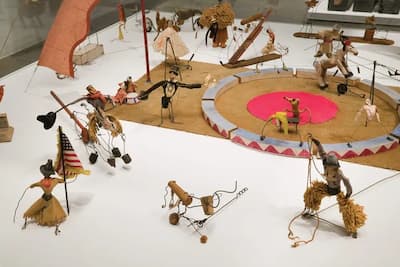
Robert S. Cohen
American sculptor Alexander Calder (1898-1976) was known not only for his distinctive mobiles but also his ‘stabiles,’ non-moving sculptures. One of his best-known ‘stabiles’ is Cirque Calder (Calder’s Circus), a collection of over 70 miniature figures and animals with over 100 accessories of the circus such as tents, nets, and flags, and an additional 30 musical instruments, phono records and noisemakers. In Paris, where he first showed this work, Calder would personally animate each creature, setting up their situations – high wire act or center ring.
The figures and design are crude, but the audience could see the circus of their imagination, sparked by Calder’s designs. A film was made in 1955 showing Calder putting his circus into action.
Alexander Calder performs his “Circus”
This video of the circus inspired American composer Robert S. Cohen to create his own soundtrack to some of Calder’s actions.
Big Top Parade captures both the circus aspect and the idiosyncratic movements of Calder’s hand-animated figures. The circling music imitate the figures in motion, both on the ground and in the air. The writing also seems to capture the 1920s style of the sculpture as a whole.

The Ringmaster and the Lion (Whitney Museum)
Robert Cohen: Calder’s Circus – I. Big Top Parade (Sunderman Wind Quintet)
The strong man enters with a grand gravity.
Robert Cohen: Calder’s Circus – II. Rigoulot, the Strong Man (Sunderman Wind Quintet)
Calder’s lion is all mane and tail, but Cohen’s piece captures him as he’s about to sleep but then a mouse begins to run about.

Calder’s Lion (Whitney Museum)
Robert Cohen: Calder’s Circus – III. Lion Lullaby with Mouse (Sunderman Wind Quintet)
The clowns enter – one removes coat after coat, starting with a coat that looks not unlike the lion. They play and clown around.

Camel, Clown, and Kangaroo (Whitney Museum)
Robert Cohen: Calder’s Circus – IV. Doze Friggin’ Clowns (Sunderman Wind Quintet)
In 2019, the entire Calder’s Circus went back on permanent display at the Whitney Museum in New York. All the figures, including cowboys and cowgirls, acrobats, a bull with elongated horns, and artistes doing tricks on the backs of galloping horses are now visible.


Calder’s Circus (detail) (Whitney Museum)
Unfortunately, the sculpture is now too frail to be animated again as Calder used to do it, but with the help of the 1955 film, we can see how Calder, entering with his five suitcases, would unpack and perform.
A longer selection from the 1955 film includes more figures.
Le Cirque de Calder

Man Ray: Jean Cocteau with a portrait
made of pipe cleaners (ca. 1926)
Critics consider this wire-sculpture assemblage to be the first statement of Calder’s art and a precursor to Calder’s well-known mobiles. Calder’s wire sculptures inspired French artist Jean Cocteau’s own experiments in portraiture with pipe cleaners, but it was clearly the younger sculptor who was the inspiration.
Although the colours of the circus are now dimmed and faded, their original colors were bright and vivid and the intense color was important to Calder. Unfortunately, as a poor young artist in Paris, he could only afford cheap materials, so now the cheap leather decorations on the cowboy tend to fragment – restoration at the Whitney could only stabilize it, not replace it.
Cohen’s music for Calder’s Circus finally gives a great artwork the music accompaniment it always needed.
For more of the best in classical music, sign up to our E-Newsletter




